Some people like to settle for having a plant or two in the home, just to add a touch of color, but for others that is simply not enough. Having an assortment of beautiful plants in the home creates an atmosphere of enchantment, especially when you’ve got a wild assortment of vibrant colors and arrangements. It’s really like stepping into another world and even better, it’s your world!
Today we’ve brought you an assortment of 18 colorful houseplants that you can use to add some truly amazing color into your own home. We’ve tried to include a little of everything and we hope that you’ll see something that you like.
Our Favorite Colorful Houseplants
Without further ado, let’s take a look at a few of Nature’s superstars of color!
1. Ti Plant – Cordyline fruticosa
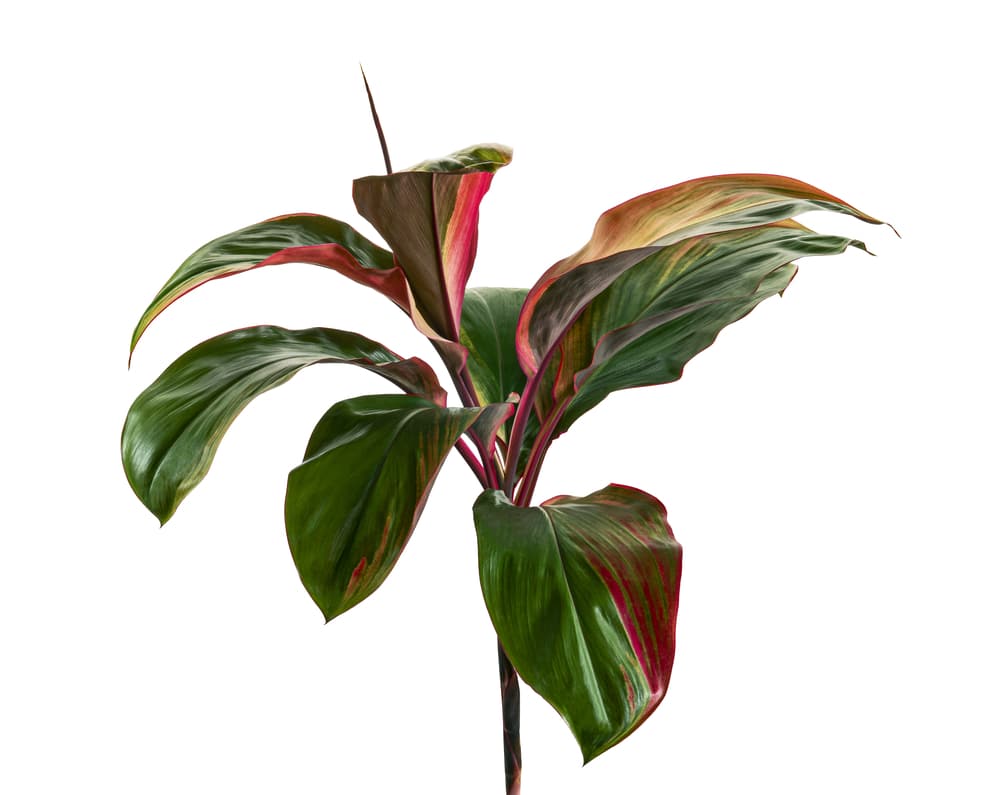
Our first entry in this cornucopia of color it the Hawaiian Ti plant. This tropical lovely brings some amazing purple and dark pink leaves into your home, but you can also find them in a striking red, cream, and lighter pink cultivars if you look around a little. While these plants may indeed be grown indoors, you’ll need to manage them over time, as they are members of the Evergreen family and can grow as large 10 feet tall. That’s quite a lot of color indoors, indeed!
For growing your own inside the house, you’ll need a potting soil which is first and foremost fluoride-free, as these beauties are sensitive to this. Peat-based mix with perlite for good drainage is just about perfect. As far as sunlight, give it full, direct sunlight, and you’ll want to water it when the top 2 inches are dry. Finally, only used distilled water – fluoride can damage the leaves of these lovelies.
It’s a lot of work to raise these plants indoors, but well-worth the effort.
2. Nerve plant – Fittonia albivenis

Also known as the ‘Mosaic plant’, this indoor option is much more compact but nonetheless quite striking. The intricately leaves make this plant a popular choice and you can find them in reds, pinks, greens, and sometimes whites. We’re aren’t kidding about the compactness, either, as these grow about half a foot with leaves about 4 inches long.
To house your Nerve plant, a peat-based potting mix is all that is required, and light to medium, indirect sunlight is best. Water it when the soil is about 50% dry and you’ll have a happy, healthy plant.
3. Spiderwort – Tradescantia zebrina

Easy to propagate, Spiderwort comes in an amazing assortment of colors, such as vibrant purples, lime-greens, and more. Its blooms will open towards late spring or early summer and while they are considered weeds in some countries, they are highly prized by many as colorful and desirable houseplants. Spiderwort is also modestly sized, growing around 6 to 12 inches tall and up to 12 to 24 inches wide.
You’ll want to plant your Spiderwort in a peat-based potting soil with some perlite for good drainage and full sunlight with partial shade is best. Water it approximately once a week or when the top inch of soil is starting to feel dry.
4. Purple Passion Plant – Gynura aurantiaca

The Purple Passion is a great addition to any indoor garden and has quite the striking look to it. The leaves themselves are green, with a purple feathering of hairs that really draws the eyes. They’re also a great fit for a hanging basket, as they will grow to be a modest 3 feet long and 3 feet wide at full maturity.
A soil mix of 2 parts peat and 1 part perlite are ideal for the Purple passion and bright, but indirect sunlight is best. Watering should be done every 1 to 2 weeks or when the top 2 inches of soil are getting dry. Finally, these plants prefer colder temperatures, so pick a location inside that stays around 60 to 70 degrees to keep them happy.
5. Anthurium – ‘Tickled Pink’ variety

If you love beautiful, light-pink blooms that can appear year-round atop purplish stems, then the ‘Tickled Pink’ Anthurium is an excellent choice. Anthurium also comes in a large number of other colors, depending on the specific variety that you select, and they are all quite easy to care for! At full maturity, expect a height of 12 to 18 inches and a width of 9 to 12.
For your soil, select an orchid mix and a bit of coarse sand so that it drains well and bright, indirect sunlight will be best for this plant. Watering should be done when the topsoil has dried, which is generally going to be once every week.
6. Urn plant – Aechmea Fasciata
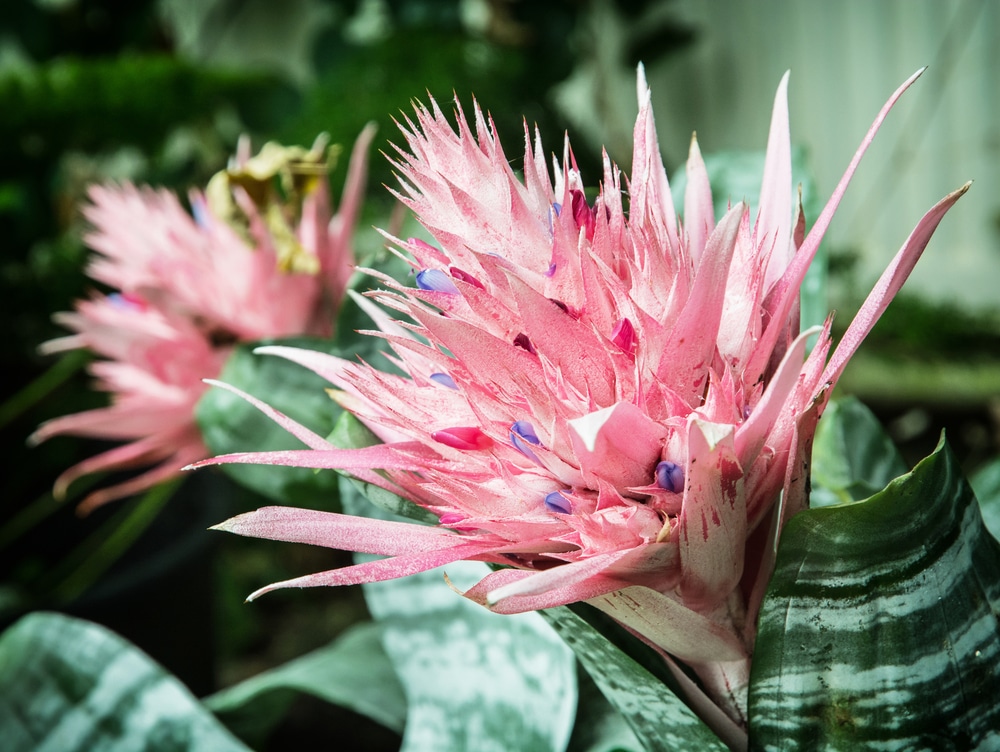
The Urn plant gets it’s name from the shape of the stiff, pointed, and colorful leaves that sprout out from it in an Urn-shape, designed to collect and hold water. Needless to say, this exotic beauty is one of the most popular Bromeliads to have at home. While they take about 2 years to bloom, the amazing bracts of blue, yellow, or red will stay around about 4 to 6 months and once you’ve seen them in person, you’ll definitely want your own. As far as size, when grown indoors you can expect a height of about 30 inches once it has reached full maturity, with a spread of approximately 24 inches.
Orchid potting mix is going to be your best and easiest option for your own Urn plants and they like bright, indirect sunlight. Watering is the interesting part, as the plant’s urn needs to have water at all times, while the soil should be watered every 2 to 3 weeks.
7. Cyclamen – Cyclamen persicum

Cyclamens are another exotic and colorful choice, with upswept flowers of pink, purple, red, or white, which are gracefully raised about dark greens leaves with silver tracings on them. Despite all that beauty, this is a compact choice with a height of about 9 inches tall at full maturity.
For their soil, Cyclamens like a little acidity in the mix, so you’ll want to mix a small amount of Sphagnum in with a standard potting mix to ensure that your plant is comfortable. Bright, indirect sunlight will best for this plant and after that, simply water it once a week in the warmer months and every 10 days in the winter.
8. Madagascar Dragon Tree – Dracaena marginata
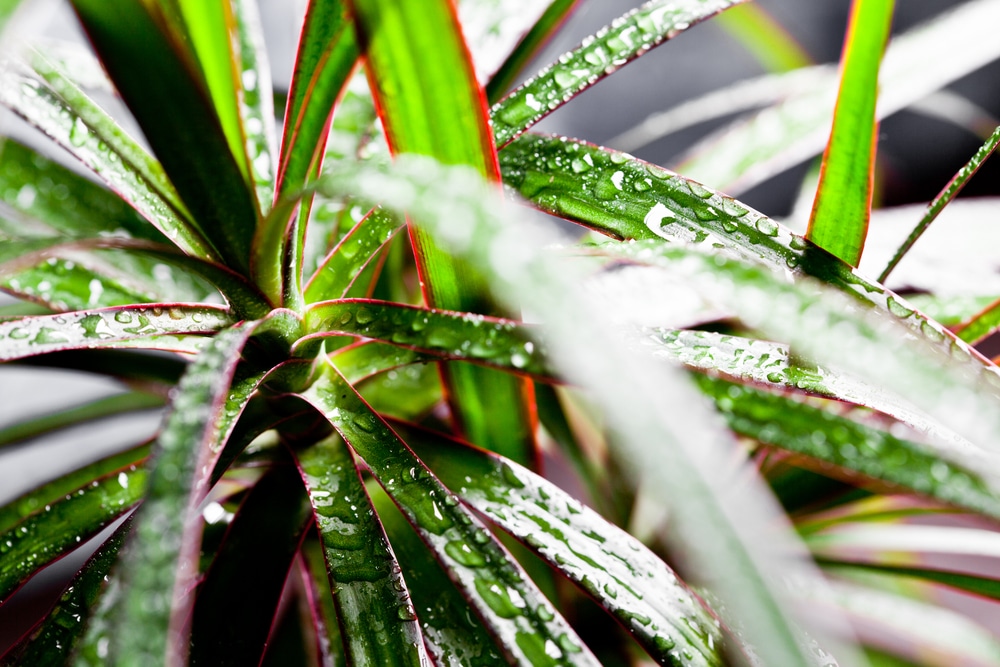
The Madagascar Dragon Tree is another unforgettable plant, with long, thin green leaves which are tinged with bright pinks and reds. The fully mature height of this plant can be as much as 6 to 15 feet, but they are very slow growers, reaching around 5 feet in size in a period of around 10 years. Due to their good looks, slow growth period, and the fact that you can slowly prune your tree over time, Dragon trees remain a very popular option for adding color to the home.
Peat moss mixed in with a loamy soil is one of the best options, but a half and half mix of regular potting soil and perlite will also be fine if that is more convenient. After that, just give it plenty of bright, indirect sunlight and water it once a week in the warmer months and once every 2 weeks in winter.
One caveat… when watering, you will want to used distilled tap water, as these lovely plants are sensitive to fluorite and this may damage the leaves.
9. Chives – Allium schoenoprasum

A choice on your list that might have expected, Chives actually have very lovely purple or pink flowers that you’ll get to see around the middle of spring or in early summer. Best of all, they’re easy to raise and a treat to eat! When you are choosing colorful plants for your home, herbs are a choice that a lot of people forget, so consider some chives and other herbs to brighten up your kitchen with the rest of the house!
All you need to grow them will be a standard potting mix with a little perlite for draining, 6 to 8 hours of direct sunlight, and once or twice a week of watering. For the watering, just make sure that the soil has dried before you water again.
10. Moth Orchid – Phalaenopsis
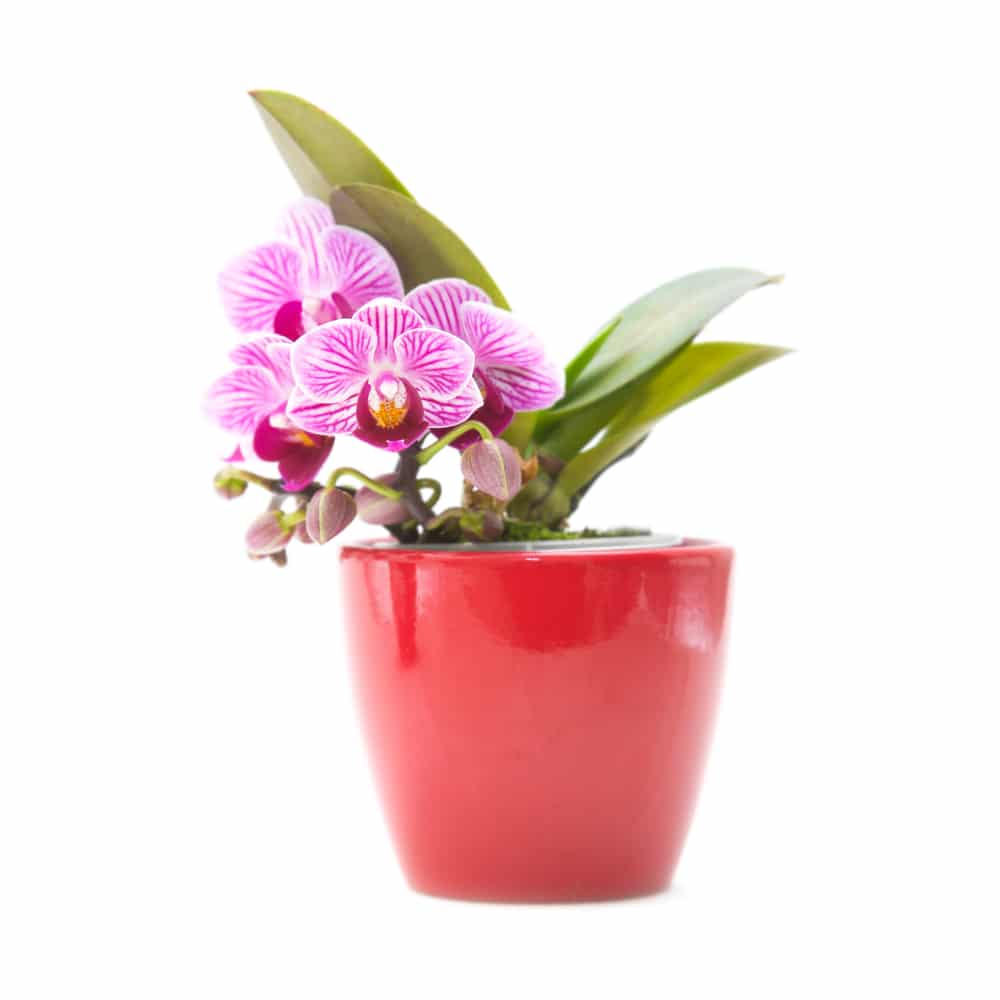
There are about 70 species of Moth orchids and each one seems more colorful than the next! With long and thin leaves of light green, the flowers produced are a sight to behold and give the origins of it’s name – they look rather like a moth in flight. Given that they are easy to take care of and that their blooms will last for months, they’re a great way to add a little color and elegance to the home. They’ll grow to be anywhere from 6 inches to a foot tall and about 12 inches wide at full maturity, so they also won’t take up much space.
If you like one of your own, you’ll need to grow it in peat moss or bark, and it will need bright, indirect sunlight. As far as watering, if you are using peat then water when the top of the peat feels dry and for bark, watering once a week should be just about perfect.
11. Bird of Paradise – Strelitzia reginae

The Bird of Paradise has long and lush stems with sharp and colorful ‘beaklike’ flowers crowning them gracefully above. Said flowers are mixes of yellows, oranges, and blues, and each is delicately cupped in a lovely curved leaf. While they grow to be as high as 30 feet in the wild, indoors they will only grow to be about 5 or 6. You’ll have to wait awhile for those flowers, though, as your plant is going to need up to 5 years to mature. We can assure you, however, that they are well worth the wait!
Bird of Paradise will need a peat-based soil with some coarse sand mixed in and bright, indirect sunlight as well. Watering is quite minimal, with once a week in the warmer months and once every 2 weeks in the winter.
12. Calamondin Orange – Citrofortunella microcarpa

Fancy the thought of a tiny orange tree in your own home? That’s exactly what get with the Calmodin Orange tree. Native to China, these little trees are a cross between the kumquat and mandarin, and they will not only add vibrant color to your home but you’ll also get to enjoy their lovely fragrance. While it will take about 2 years before they will bear fruit, they will do so year-round after that and you’ll occasionally get little white flowers to go with those dark, green leaves and beautiful, bright oranges. As far as space, they can grow up to 8 feet indoors, so you’ll want to do a bit of pruning and put your own Calmodin somewhere with a good amount of space.
A peat-based mix with perlite for drainage will work best for potting your Calamondin and you’ll want to give it as much direct sunlight as you can. As far as watering, when the soil dries out you’ll want to give it a thorough to-the-roots watering, which will usually translate out to every 10 days.
13. Gloxinia – Sinningia speciosa
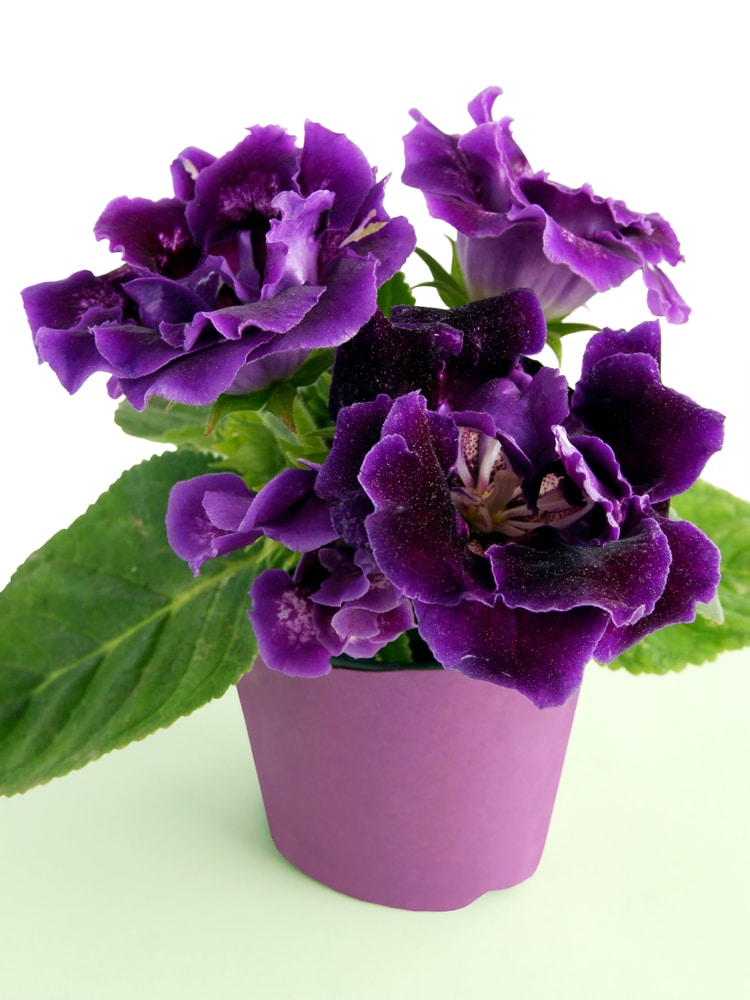
A relative of the African Violet, Gloxina’s will give you bell-shaped flowers of blue, red, purple, pink, or white which are nestled in a lovely bed of large, medium-green leaves. While the leaves have a slightly-rough texture to them, the flowers have a smooth, velvety one that completes the elegant look of this plant. They are also quite compact, growing between 6 and 10 inches tall with 2-inch flowers, so you can put your Gloxinia just about anywhere in the house that you’d like.
For Gloxinias, African Violet potting mix is perfect, and you’ll want to give it bright, indirect sunlight. Watering should be fairly frequent, typically every 2 to 3 days or when the top ½ inch of the soil is dry.
14. African violet – Saintpaulia

This is one that most of us already know and love… and for good reason! Despite the name, the African Violet can also be found with pink, blue, or white blooms and those tiny flowers and big fuzzy leaves have never gotten old. As far as their size, you have mini and larger varieties, ranging just under 6 inches and up to 12 inches in height, with respective widths of 3 to 16 inches. With a little mixing and matching, you can definitely make some very colorful and interesting displays.
African Violet potting soil is best, of course, and you’ll want to give them as much bright, indirect sunlight as you can for superior blooms. Watering can actually vary a bit between your plants, but it usually comes out to once a week. Just check the top inch of soil and if it’s dry, then it’s time to water your Violet.
15. Geranium – Pelargonium

Another classic, Geraniums often get overlooked because everyone has heard of them and many folks would rather have the most exotic plant possible. This is a shame. First off, as far as colors, you have an enormous range. Oranges, purples, peach, pinks… just to name a few. They also come with varying overall looks. This gives you a wide range of decorative options but the fun doesn’t end there. The fragrant leaves and flowers are actually edible and there are a wide variety of flavors. You can add peppermint flavors, lemon, and more, making these a perfect choice both those love color and the culinary arts.
We’re just saying… don’t write off Geraniums just because they’re well-known. It’s a reputation that they have earned!
As far as soil, Geraniums will love a mix of perlite, peat, and regular potting soil, and they are going to need 4 to 6 hours of sunlight in order to look their best. Watering should be weekly, provided that the soil has dried out down to a depth of 4 inches. Just give them a quick weekly check and you’ll learn the ideal schedule in no time!
16. Lipstick Plant – Aeschynanthus radicans

The Lipstick plant is quite the looker, with a cascading flow of medium-green, spade-shaped leaves and their namesake flowers tubular and red flowers. Said flowers have a lovely wine-purple bud to complete their exotic look and they are definitely a sight to see. These vining plants are an excellent choice for hanging baskets, but this choice may be a better fit for bird lover’s looking to make a beloved pet happy. This is because lipstick plants have a mild fragrance to it which birds seem to love (especially hummingbirds) but which humans might find a bit of an ‘acquired taste’. One nice decorative workaround if you happen to have hummingbirds in your area is a hanging pot outside one of your windows. That way you can get a little color and some little visitors in the bargain. Just note that this plant won’t like temperatures under 65 degrees. These plants will grow up to 3 feet in length.
Lipstick plants do well in a mix of equal parts regular potting soil, perlite, and peat, and bright, indirect light if it is inside. If outside, put it in a partially shady area and avoid areas with direct sunlight. For watering, check that the top 2 inches of soil are dry and if they are, water it moderately. This will likely come to a schedule of once a week but you’ll want to check to learn the schedule, as these lovelies are quite sensitive to overwatering.
17. Croton – Codiaeum variegatum

Crotons give you an amazing amount of variety when it comes to your colors and even the looks of the leaves. You’ll see classically ribbed leaves, speckled ones, striped ones… and each will be tinged with colors that you choose. There are even rainbow varieties and they’ve got to be seen to be believed. As far as their size, Crotons will get about 6 feet tall and about 5 foot wide, but they are easily managed with a little pruning and believe us… it’s worth it!
For your soil, mix a standard potting soil with some perlite and peat and your Croton should be happy. This tropical also likes full sunlight and this is going to affect the color quality greatly, so you’ll want to place it by a south-facing window. Finally, your Croton’s soil needs to stay moist, so you should water it every 3 – 7 days of when the top ½ inch of soil is dry.
18. Brazilian Fireworks – Porphyrocoma pohliana

Our final entry is a tropical beauty known as Brazilian Fireworks and we think you’ll love the look of it. The name is actually quite appropriate, as once it starts to lose color, these plants actually shoot out little black seeds like fireworks! That said, as far as color in the home, you get a nice combination. These plants have large, silver-veined leaves and clustered flowers which boast pink and purple spikes! Despite all this character, you can easily find a place for them, as they only grow to a height of 6 to 12 inches tall and 8 to 15 inches wide. It’s colorful and definitely a conversation starter!
Pot your Brazilian Fireworks in a standard, high-quality potting soil and liquid fertilizer is recommended each month for best results. Give it lots of bright, indirect sunlight and water it twice a week or when the top 2 inches of soil are dry!
Conclusion
We hope that you’ve enjoyed this little collection of colorful houseplants and that it’s given you some fun ideas for your own home. There’s nothing quite like bringing nature inside, especially when it comes with the wow factor of so many exotic shapes and colors. With a little planning and color-coordination, you can make your home look almost otherworldly. Until next time, we wish you and your beautiful new plants the very best!

